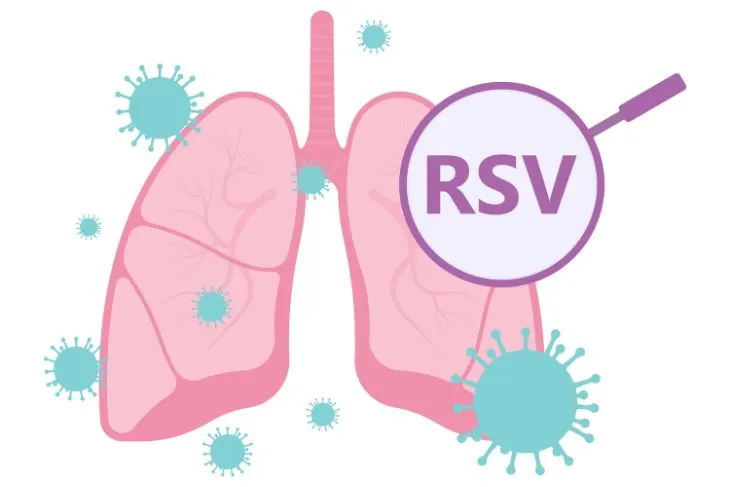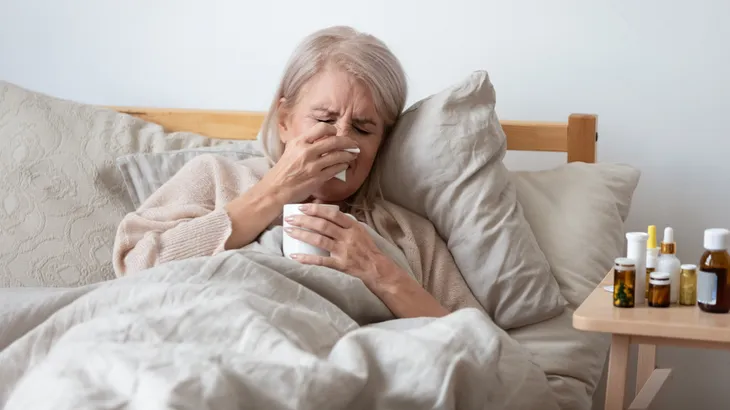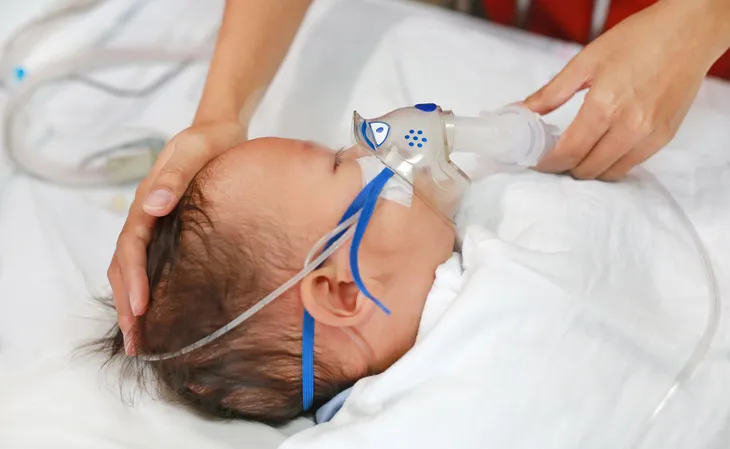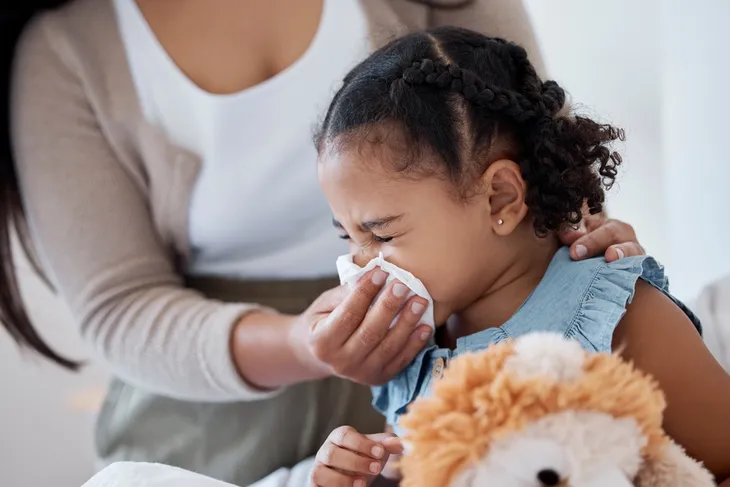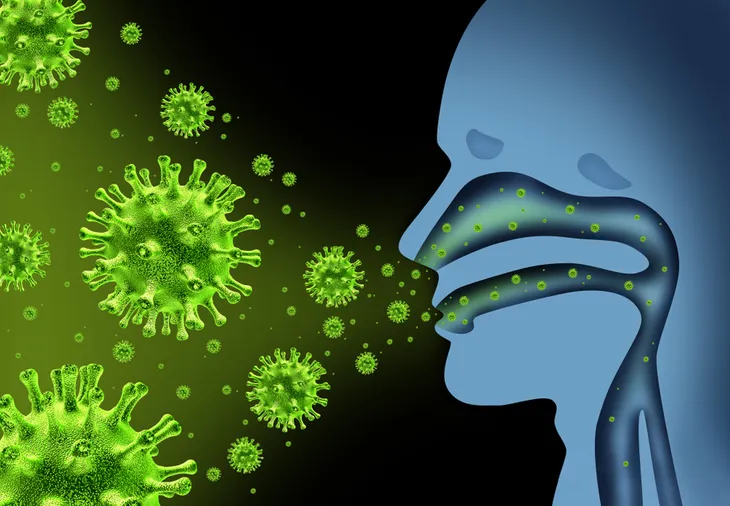- RSV mimics the same symptoms as the common cold making it difficult for parents to distinguish between the two.
- However, RSV can spread into the lower respiratory tract making it especially dangerous for infants and seniors.
- Emergency care is required for any difficulty breathing, noisy breathing, or a blue/gray skin color.
- Mild cases of RSV follow the same treatment as a cold with at-home care and over-the-counter (OTC) medication.
Every winter parents of little ones are on high alert for respiratory syncytial virus (RSV). This virus peaks during cold and flu season and mimics cold symptoms, making it hard to detect. But unlike a cold, RSV can make its way into the lower respiratory tract, making it especially dangerous for newborns and infants.
To help parents determine whether their child is suffering from the common cold or something more serious like RSV, we’re breaking down the details of each virus. Here’s a look into the symptoms of each, how they are spread, treatment options, and some prevention tips…
What is the Common Cold?
Most people have experienced a cold at some point in their life, many have one at least once a year. The common cold is responsible for more healthcare provider visits and work and school absences than any other illness, says Johns Hopkins Medicine. Despite what our parents might have told us, a cold is not caused by wet hair or cold weather. However, they do occur more frequently during the early fall to late winter.
A cold is caused by any one of 200 different viruses, but rhinoviruses are the most common cause. These highly contagious viruses “spread through airborne droplets that are coughed or sneezed into the air by the sick person. The droplets are then inhaled by another person,” writes the source. They can also be spread through contaminated surfaces (i.e. doorknob).
What is Respiratory Syncytial Virus (RSV)?
Similar to the cold, respiratory syncytial virus is a viral infection in the lungs and respiratory tract. According to the Mayo Clinic, it’s such a common virus that most children have been infected with it by the time they are 2-years-old. It can also occur in adults too.
For healthy adults and children, the symptoms are often mild and mimic the common cold. Since it’s a viral infection, it can’t be treated with antibiotics. Self-care measures are often all that’s needed to relieve discomfort, notes the source. However, it can turn into a severe infection in babies under 1-years-old, seniors, and people with heart and lung disease.
Symptoms of a Cold
The symptoms of a cold usually appear 2 to 3 days after the virus enters the body, says Johns Hopkins Medicine. From here, symptoms will last anywhere from several days to several weeks. While it’s certainly an annoyance, a cold is relatively harmless. Most of the time it will clear up on its own without any formal treatment. The source does note it can sometimes lead to a secondary infection, such as an ear infection.
Johns Hopkins Medicine lists the following as the most common symptoms of a cold: a stuffy or runny nose, scratchy or tickly throat, sneezing, watering eyes, low-grade fever, sore throat, mild hacking cough, achy muscles and bones, headache, mild fatigue, chills, and a watery discharge from the nose that eventually thickens and turns yellow or green.
Symptoms of RSV
For most people (kids over the age of 3 and healthy adults), the symptoms will appear almost identical to a common cold. The reason for this is because they’ve likely encountered RSV at some point in their life and built up an immunity to it, says Amina Ahmed, MD, professor of pediatric infectious disease and immunology at Atrium Health’s Levine Children’s Hospital when talking to Parents.
The Mayo Clinic lists the following as the most common symptoms of RSV: congestion or a runny nose, dry cough, low-grade fever, sore throat and a mild headache. Sometimes RSV can progress into bronchiolitis which will result in some wheezing and a more severe cough. If these symptoms appear, it likely means there’s a lower respiratory tract infection. However, it’s still not severe enough that they need to go to the hospital, says Dr. Ahmed to Parents.
RSV in Babies and Infants
Infants under 6-months are the most vulnerable group when it comes to RSV. Their most common symptoms are fever, nasal congestion or rhinorrhea (runny nose), and a cough.
The Cleveland Clinic points out that not all babies will show the “classic” signs of RSV like coughing or a runny nose. This is particularly true for babies under 6-months old. Their symptoms may only include: fussiness or irritability, poor feeding, lethargy, minimal interest in activities, and shallow, rapid breathing which can lead to distress.
The source also adds that babies under 6-months-old with RSV may have to stay in the hospital to have their breathing and oxygen levels monitored, especially if they have other chronic health issues.
RSV in Elderly Seniors
Similar to infants, elderly seniors can become extremely sick from RSV and it’s often due to their compromised immune system. This heightened means they are more likely to develop a lower respiratory tract infection, such as pneumonia which can cause wheezing or difficulty breathing, explains Parents. If this occurs, they may need oxygen and require hospitalization.
Parents lists the following as extreme symptoms of RSV that require immediate medical attention: cyanosis (a blue tint) of the lips and/or nails, high fever, deep cough with wheezing, and difficulty breathing.
Recognizing Emergency Symptoms of RSV
It’s extremely important for parents and caregivers to be able to recognize severe symptoms of RSV in babies and toddlers. According to the Cleveland Clinic, call 911 or visit the emergency room (ER) if any of the following occur:
- Noisy breathing
- Flaring (spreading out) of nostrils with every breath
- Blue or gray color to their lips, mouth, and fingernails
- Belly breathing or “caving in” of the chest in the form of an upside-down “V” starting under the neck
- Short, shallow or rapid breathing
- Pauses while breathing
Symptoms in adults and healthy kids that require a trip to the ER are difficulty breathing (pauses while breathing or short, shallow and rapid breathing), noisy breathing, or a blue/gray skin color. The source also advises calling your healthcare provider if you have RSV symptoms and are over the age of 65, have a compromised immune system, or a heart or lung condition.
Biggest Difference Between a Cold and RSV
Unlike a cold, RSV has the potential to spread into the lower respiratory tract which can lead to either pneumonia or bronchiolitis, warns the Mayo Clinic. This is particularly dangerous for infants and the elderly. A big indicator is any changes in their breathing. Parents should keep watch for signs of short, shallow, and rapid breathing.
Another key indicator in differentiating between a cold and RSV is the sneezing and nasal mucus. According to WebMD, people with RSV will likely be sneezing a lot more and have “copious amounts” of nasal mucus (aka snot) from a runny nose, and some wheezing. Wheezing is a whistling sound while breathing which results from inflammation in the small airways of the lungs.
“With RSV, it’s more of the upper respiratory type of infection, and people tend to have more of what we call bronchiolitis,” says Mobeen Rathore, MD, a member of the American Academy of Pediatrics’ Committee on Infectious Diseases to the source.
How is a Cold Spread?
Both the common cold and RSV are highly contagious viruses that spread rather easily between people. In the case of a cold, the virus is spread through droplets in the air when someone who is sick coughs, sneezes, or talks. The Mayo Clinic adds, from here it enters the next body through either the mouth, eyes, or nose.
You can also catch a cold through hand-to-hand contact with another sick person or by sharing objects like a utensil, towel, toy, or telephone. People who touch their eyes, nose, or mouth after interacting with a contaminated surface are likely to get sick, warns the source.
How is RSV Spread?
RSV is spread the same way a cold is — through the air on infected respiratory droplets or direct contact with a sick person. What is most scary about this virus is that it can live for hours on surfaces, says the Mayo Clinic. And if a person touches this surface and then their eyes, nose, or mouth they will pick up the virus.
The source warns that people are most contagious in the week or so after they’ve become infected. “But in infants and those with weakened immunity, the virus may continue to spread even after symptoms go away, for up to four weeks,” adds the source.
Treatment Options for RSV and Cold
Unfortunately, there is no medication that can cure a common cold or even shorten its duration. Since it is caused by a virus and not a bacterial infection, antibiotics will not work. All anyone can do is take OTC cold medicines to relieve their symptoms for the time being. Johns Hopkins Medicene also states that rest, increased fluids, pain relievers, gargling salt water, steam for congestion, petroleum jelly under the nose and lips can all be helpful.
Since RSV is similar to the common cold it also doesn’t require any treatment, notes the Cleveland Clinic. In fact, mild RSV doesn’t even require a trip to the doctor. It will often go away on its own within one or two weeks. You can follow the same at-home treatment as a cold. However severe RSV requires immediate treatment by a doctor.
Prevention Tips
Prevention tips for the common cold and RSV are similar. Most of these are just common sense practices that people are hopefully already doing to prevent spreading viruses. The first most important is to wash hands regularly for 20-seconds, says the Mayo Clinic. If soap and water isn’t available, use hand sanitizer with at least 60-percent alcohol.
Clean and disinfect high-touch surfaces frequently, especially when someone in the house is sick. Cover coughs and sneezes with tissues, into an elbow or the fabric of your shirt. Quickly throw tissues away.
The Cleveland Clinic also advises avoiding close contact with others when sick and keeping children home from school or daycare when they or others are sick. You should also limit time spent in large social settings during RSV season.


